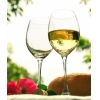|
 By the thesaurus, a wineglass is defined as a glass tallbay
with the volume of 200-250 ml used for mineral water or fruity water and wine.
Today a tallbay is considered as the developed drinking horn or a sophisticated
bowl, dipper, cup or even a wine bowl. The wineglass appeared long time ago
though looked differently. In fact first wineglasses appeared in the XVII century
when the glass-blowing art was developed. And up to this time all the materials
available to manufacture the containers for drinking beverages included metal,
wood, ceramics and bone. By the thesaurus, a wineglass is defined as a glass tallbay
with the volume of 200-250 ml used for mineral water or fruity water and wine.
Today a tallbay is considered as the developed drinking horn or a sophisticated
bowl, dipper, cup or even a wine bowl. The wineglass appeared long time ago
though looked differently. In fact first wineglasses appeared in the XVII century
when the glass-blowing art was developed. And up to this time all the materials
available to manufacture the containers for drinking beverages included metal,
wood, ceramics and bone.
Wooden or ceramic wineglass is nonsense and it is easier and
more logical to make a bowl or a dripper from wood. Bone is the traditional
horns to drink wine, and here the only thing to do is just to slightly decorate
the horns. Metal was usually used to make cups and precious metals and stones
were used for the solemn cups. And the wineglass is something very fragile
which is known for its delicacy. And the appropriate raw material is required
to manufacture wineglasses, glass or crystal.
Wineglasses differ in shapes; they come astonishingly narrow
and wide, tall or short glasses, tulip-shaped or a barrel-shaped, with the
tightly fitted «waist» or as a bud of flower. And this variety is not just happened
incidentally. The point is people believe that the taste of what you drink
depends on the shape from where you drink.
Claus Josef Riedel made this stunning discovery in 50s of
the ХХ century, from the family of glassblowers, the father to the present
owner of the reputed company Riedel, the manufacturer of the Bohemian glass
since 1890.
Such discoveries are called revolutionary since it appeared
that the shape of a glass may build the taste of wine. It turned out that a shape
of the glass or bowl can change the flow of wine to particular areas of the
roof of mouth or a tongue, and they are responsible for various tastes, in
their turn. Thus, the tip of the tongue is responsible for the sweet taste and
thus, the containers recommended to drink dry and cool white wine should be
with necks tapering off. For the sweet and oily wines the recommended glasses
should have wider neck, on the contrary, that helps to avoid the «sweet» tip of
the tongue and go to the are sensitive to acid, and in this case the sweet of
the beverage has more spicy note of acidity and the gamma of taste gets wider.
However, when using wineglasses, bear in mind that the shape
of the glass is not the only thing to influence the taste of wine. The size matters
as well. And this is why not all wine is drunk from glasses. So, red wine is the
best to drink from the container of 70-100 ml not more, while the size of the glass
should be much more than 200-250 ml. But the «flut-shaped» wineglasses (with gradually
widening neck and then getting narrow off the 2/3 of the glass height) or «flur-shaped»
(used for vintage wine) of 200 ml go well with champagne and sparkling wine. The
size and shape of glasses allow wine to be poured to the three fourth of the
capacity for the taste to draw and stronger aroma.
«Sniffer-shaped» glasses are recommended for cognac. They
resemble tulips, slightly squeezed on the bottom with the wider bottom and
tapering off neck. Cognac is poured to the level of the widest part to have the
surface of the liquid to exhale the aroma, and the narrow neck allows keeping
the aroma offering it to the gourmet all right. This is interesting that «sniffers»
somewhat vary in shape, depending on cognac category. So, younger cognac (of
V.S or V.S.O.P categories) are drunk from «sniffers» with slightly tapering
neck since such drinks are too aggressive and spirit notes are too strong in
the whole bouquets.
Relatively wider neck of the «sniffer» allows leaving spiky scent
keeping fruit notes which adds attractiveness to the cognac. The old good cognac
of Х.О. category is tasted from the maximum tapering off «sniffers» (as tasters
say «tube»), that leaves unbroken the note of fruits, the gamut and delicacy of
the drink, without tough spirit notes.
Also the «sniffers» are used for brandy (though it is well
known that cognac is brandy but not all brandy is cognac).
Anyway, the wineglasses are not so much adapted to have alcohol
drinks, and first, because of little capacity. Thus, goblets are available in more
variations up to 3000 ml and they are especially used as the glass for wine, champagne,
cognac and other alcohol drinks, though many beverages require lesser volume than
the minimal volume of the glass, and many of them require more than the glass
provides. Thus, wineglasses present mainly the containers for fruity
nonalcoholic beverages and mineral water that look very nice on the duly served
table adding crystal play.
|